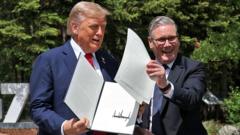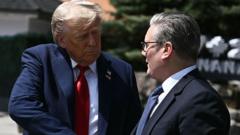In a pivotal election that could redefine Canada-U.S. relations, Canadians are set to elect a leader capable of tackling President Trump's aggressive trade moves. The candidates, current Prime Minister Mark Carney of the Liberal Party and Conservative leader Pierre Poilievre, are drawing clear battle lines over how best to handle tariffs that have unnerved Canadian industries.
Canada's Election: Gearing Up for a Trade Showdown with Trump

Canada's Election: Gearing Up for a Trade Showdown with Trump
As Canada heads to the polls, candidates outline strategies to confront U.S. tariffs and trade policies.
The election, taking place on Monday, has developed into a referendum on which candidate can effectively confront the U.S. Gauntlets of tariffs and contentious relations with the U.S. under Trump's administration hang heavily over the campaign. Carney, having taken office a little more than a month ago, emphasized during a recent debate the need to approach negotiations "from a position of strength."
Both Carney and Poilievre have vowed to respond forcefully to the tariffs that threaten Canadian jobs and exports. As Trump’s trade war escalates, leading to factory closures and layoffs, Canadian patriotism has surged, fueling resentment towards the United States. Unlike Mexico, which has adopted a conciliatory approach, both Canadian leaders are committed to standing firm.
Carney has proposed implementing retaliatory tariffs and suggested the creation of an "all-in-Canada" network for manufacturing auto parts. Meanwhile, Poilievre has underscored the need for immediate tariffs to "deter" further trade attacks from the south. Canada has already introduced tariffs expected to generate significant revenue, affecting various sectors, especially automobiles and steel.
Diverse strategies form the crux of each candidate's campaign. Carney’s background as a central banker and his meetings with European leaders illustrate a push to diversify Canada's trade relationships. Conversely, Poilievre's focus on energy exports draws attention to Canada's heavy dependence on U.S. markets for over 80% of its energy products.
Despite their differing approaches, neither candidate has fully outlined comprehensive plans to navigate the evolving trade landscape. Polls suggest that while the Liberals lead in public support, both parties stand to gain significantly in parliamentary representation. The outcome of this election could have profound implications for Canada’s future in a contentious global trade environment.
Both Carney and Poilievre have vowed to respond forcefully to the tariffs that threaten Canadian jobs and exports. As Trump’s trade war escalates, leading to factory closures and layoffs, Canadian patriotism has surged, fueling resentment towards the United States. Unlike Mexico, which has adopted a conciliatory approach, both Canadian leaders are committed to standing firm.
Carney has proposed implementing retaliatory tariffs and suggested the creation of an "all-in-Canada" network for manufacturing auto parts. Meanwhile, Poilievre has underscored the need for immediate tariffs to "deter" further trade attacks from the south. Canada has already introduced tariffs expected to generate significant revenue, affecting various sectors, especially automobiles and steel.
Diverse strategies form the crux of each candidate's campaign. Carney’s background as a central banker and his meetings with European leaders illustrate a push to diversify Canada's trade relationships. Conversely, Poilievre's focus on energy exports draws attention to Canada's heavy dependence on U.S. markets for over 80% of its energy products.
Despite their differing approaches, neither candidate has fully outlined comprehensive plans to navigate the evolving trade landscape. Polls suggest that while the Liberals lead in public support, both parties stand to gain significantly in parliamentary representation. The outcome of this election could have profound implications for Canada’s future in a contentious global trade environment.





















